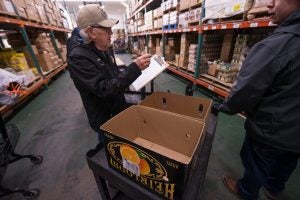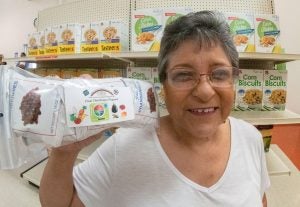In September, the Supplemental Nutrition Assistance Program (SNAP) Tribal Food Sovereignty Act was introduced in the U.S. Senate by Republican Sen. Mike Rounds of South Dakota and Democratic Sen. Tina Smith of Minnesota.
The SNAP Tribal Food Sovereignty Act seeks to give tribal governments permission to apply the federal SNAP food assistance program in a manner conducive to their tribal society and government. This can only occur after the actions of the act are met by amending the Indian Self-Determination and Education Assistance Act to allow the secretary of agriculture to relinquish the power of self-determination for SNAP eligibility to tribal governments.
Once tribes receive that power to self-determine SNAP eligibility among their tribe, each individual tribal government will determine the criteria of approval that each tribal member in that specific tribe will need to meet to receive assistance.
“The bill would make sure that SNAP is run in a culturally appropriate way that promotes the health and economic well-being of tribal communities,” Rounds said. “Our legislation would allow tribes the ability to administer SNAP to meet the specific needs of their communities.”
When Rounds shares that the bill would make sure SNAP is culturally appropriate for tribal groups, he is sharing that the bill seeks to revise the structure of how SNAP is delivered to tribes in a way that meets the tribal communities’ cultural ways of being. In the past, distribution was defined by an Americanized practice that required the tribes to fit into. However, the lifestyle of a tribe is very different than the lifestyle of folks who are not tribal or who live outside the tribe. And with tribes and their governments often operating differently than the federal government and considering the rise of food insecurity building within tribal communities, there came an obvious need to revise SNAP. This can only be done through cultural appropriate means that the tribe itself would understand and know how to administer based off their understanding of their culture.
To apply for SNAP food assistance, the tribal community would now need to go through their own tribal government and complete a specific application that meets the criteria established by their own community.
Prior to this legislation, the SNAP food assistance program for tribal communities ran predominately through the U.S. Department of Agriculture. The program hadn’t been administered to tribal communities very equitably.

For decades, Indigenous peoples who lived on or near reservations have participated in two separate USDA food assistance programs: One is SNAP, and the other is the Food Distribution Program on Indian Reservations (FDPIR). According to contractors and cooperators of the economic research service branch for the USDA, both programs have similar requirements. However, the method and participation vary between the two.
SNAP’s benefits are delivered to an applicant via debit card used to purchase food from authorized vendors. FDPIR’s program provides a basket of food items to the applicant. Unfortunately, a household can’t participate in both programs at one time. Not only are these food assistance programs run by a federal department that hasn’t implemented culturally appropriate means, but they also have created less opportunity for folks in tribal communities to have flexible food assistance.
A compounding fact to an already unfavorable food assistance debacle, is the state of indigenous communities. On average, Indigenous peoples have the highest poverty rate of any racial group in the nation. And according to First Nations Development Institute, almost all Indigenous tribes in the United States are classified as residing in food deserts; nowhere near fresh food options such as stocked grocery stores or farmers markets.
“Food deserts are defined as parts of the country lacking fresh fruit, vegetables, and other healthful whole foods. … With high poverty levels, a large number of Natives experiencing food insecurity live in food deserts. … This all contributes to poor health outcomes,” the Institute says.
These outcomes include diabetes, high blood pressure, obesity and heart disease.

Each day, one of four indigenous people who are food insecure must choose between their basic needs or nourishment provided by food. Yes, they can apply for food assistance, however, tribal communities on average are 3.3 more miles away from a healthful food source than an average U.S. citizen. If both a United States citizen and a tribal community member were to purchase groceries with SNAP, a tribal community member may have more of a barrier in transporting themselves due to distance. They may then lean toward a more accessible option that may very well be less healthy for their household.
Many United States citizens run into very similar situations on a daily basis, and federal food assistance programs definitely need to make their rounds to meet every person where they are. Today’s information is specifically geared, however, to the challenges of the tribal communities, while sharing how the legislation presented in the Senate can potentially remove a few barriers for tribal community members. It is important we take a step back and understand how big this moment is for the very community members we share our country with; hopefully knowing that a better future for indigenous people is a better future for ourselves as well.
As legislation goes through its historical channels before becoming law, what can we do today as readers, listeners, community members to support indigenous communities in our collective journey toward equitable food systems?
The First Nations Development Institute shares that we as community members can converse with local stakeholders (such as schools, senior centers, community programmers) to “promote programs and policies that require more healthy and traditional options” for indigenous community members in and out or reservations. We can advocate to protect and increase funding for SNAP, WIC, and SSI for all United States citizens, which in turn will trickle to our Indigenous communities. Lastly, we can support community and school gardening programs that elevate healthy eating habits and provide opportunities for community members to learn how to use produce to make healthy meals for their household.
Again, all of this is applicable to every United States family. But when we work and advocate for one, we eventually find ourselves doing the same for the whole. By doing what we can with what agency we have as citizens to impact another person’s lives, we are also impacting our lives too; whether immediately or down the road. Legislation such as the SNAP Tribal Food Sovereignty act can result in just that.
Bre Holbert is a past National FFA President and studies agriculture science and education at California State-Chico. “Two ears to listen is better than one mouth to speak. Two ears allow us to affirm more people, rather than letting our mouth loose to damage people’s story by speaking on behalf of others.”



